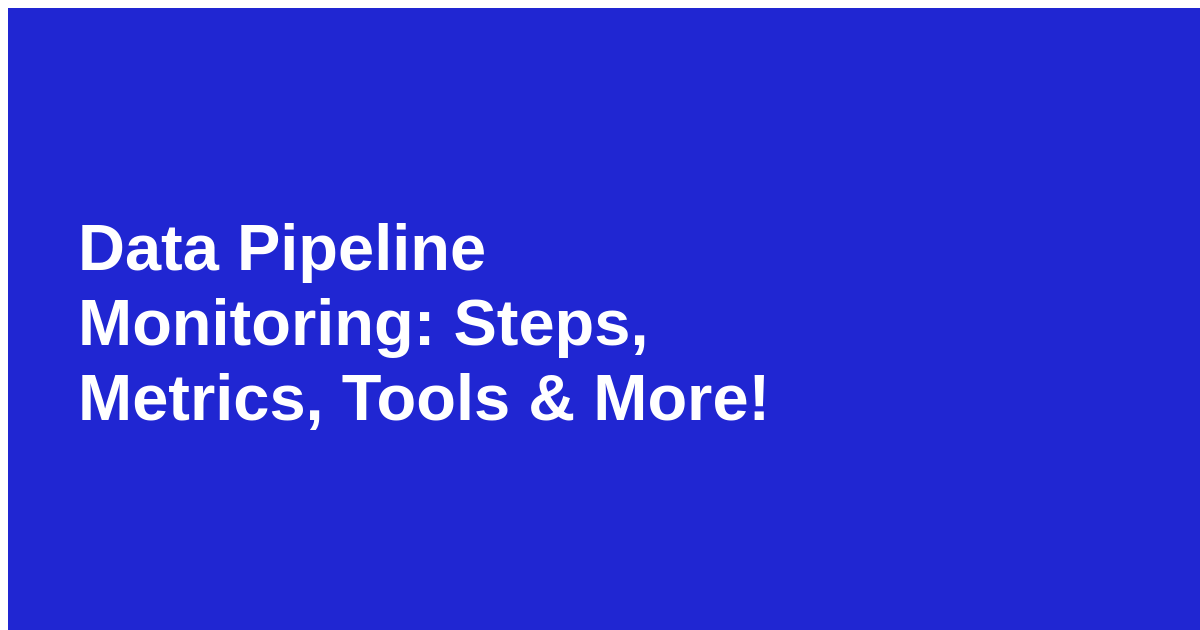Data is no longer a byproduct of business operations—it is the business. From customer preferences to operational inefficiencies, insights lie buried in your data, waiting to be uncovered. But let’s be honest: making sense of this flood of information isn’t easy. This is where the right data pipeline tool comes in. And evaluating data pipeline tools? That’s not just a technical decision—it’s a strategic one.
Choosing from among the best data pipeline tools can feel like comparing apples to circuit boards. They all promise faster processing, seamless integration, or magical real-time capabilities. But what matters when you’re under pressure to deliver insights that drive decisions? That’s what we’ll unpack here.
The Role of Data Pipeline Tools in Today’s Data Ecosystem
Consider data pipeline tools as the unseen workforce behind your dashboards, AI models, and business reports. They quietly shuttle data from databases, APIs, and IoT sensors, you name it, to where it needs to be: cleaned, sorted, and ready for action.
Some tools focus on batch processing, while others zero in on real-time data streams. The best ones do both, adapting as your needs evolve. Evaluating data pipeline tools is about ensuring they don’t just do the job today but continue doing it tomorrow when your dataset triples or your system suddenly supports multiple data streams from five new sources.
Feature 1: Scalability
Let’s get this out of the way: if a tool can’t scale, it’s a liability. You might not need massive throughput today, but what about next year when your product line expands or customer interactions double overnight?
Scalability means more than just handling more data. It means growing with your business, seamlessly adjusting without forcing costly redesigns. You want tools that adapt, not ones that break. Apache Kafka, for instance, excels here, offering a distributed architecture and built-in fault tolerance. That level of elasticity? It’s not optional anymore—it’s essential.
Feature 2: Real-Time vs. Batch Processing
Here’s the thing: not all data is created equal, and not all needs to be processed immediately. If you’re crunching sales data for quarterly reports, batch processing might be your best bet. But monitoring fraud or tracking delivery vehicles in real-time? That calls for immediate data handling.
Apache Flink, a darling of real-time processing, offers precisely that. Evaluating data pipeline tools through this lens forces you to be honest about what your business needs. Sometimes, a mix of both modes—hybrid pipelines—is the smartest route.
Feature 3: Data Integration & Connectivity
You can have the fastest pipeline in the world, but it’s useless if it can’t communicate with your data sources.
Look for tools that support a wide range of connectors out-of-the-box—databases, CRMs, cloud storage, flat files, you name it. Apache NiFi shines here, boasting hundreds of pre-built processors. That kind of plug-and-play connectivity? It reduces development time and headaches, and keeps your engineering team focused on the big stuff.
Integration is not just a technical convenience; it’s about agility. When evaluating data pipeline tools, consider the time and dollar cost of getting new data sources online. Can the tool flex?
Feature 4: Reliability and Fault Tolerance
We all know systems fail. Connections drop. Servers crash. That’s reality. The difference between a decent data pipeline tool and a great one lies in how it handles failure.
Tools like Kafka or NiFi aren’t just fast; they’re resilient. They replicate data, offer rollback options, and keep pipelines running even when parts of your infrastructure are temporarily down. Fault tolerance might not be glamorous, but it keeps your dashboards accurate and your reports honest.
You want confidence that your insights aren’t built on incomplete or corrupted data. That’s non-negotiable.
Feature 5: Monitoring and Observability
You can’t manage what you can’t measure. That’s not a cliché; it’s a fundamental truth of data engineering. Visibility into your data flows is what allows you to optimize, troubleshoot, and maintain trust in your systems.
A good data pipeline tool doesn’t just move data—it shows you what’s happening, where bottlenecks are forming, and how long each transformation takes. NiFi’s real-time visual interface is a great example. It makes the invisible visible, which you need when something breaks five minutes before a board meeting.
Feature 6: Cost & Pricing Transparency
There’s nothing worse than hidden costs. Some tools start cheap but increase expenses with every additional feature or user. Others charge for data throughput, compute time, or support.
Evaluating data pipeline tools requires a long view. Can you predict costs as your team or workload grows? Does the tool offer a usage model that matches your reality? Amazon Kinesis, for example, is priced per shard and per data unit, which works great for variable workloads but not so much for fixed budgets.
Feature 7: Security and Compliance
You don’t get a second chance when it comes to security. With privacy regulations tightening and cyber threats increasing, your data pipeline must be watertight.
Look for tools that offer rest and transit encryption, granular access controls, and audit logging. More importantly, they should make it easy to comply with industry regulations, such as HIPAA, GDPR, or local data protection laws.
The best data pipeline tools don’t treat security as an afterthought. They bake it into the architecture.
Other Variables That Matter
Tool documentation. Community size. How easy it is to hire people with experience using it. These things matter. They may not appear in a feature list, but they’ll shape your team’s day-to-day reality.
A vibrant community means faster answers and shared best practices. Regular tool updates signal long-term support, and user-friendly interfaces mean less training and quicker onboarding.
When evaluating data pipeline tools, don’t overlook the soft factors. They often make or break the long-term viability of your choice.
Making the Right Choice for Your Business
Here’s the truth: no single tool is perfect. Some are better for real-time work, and others excel at heavy batch jobs. A few do both, but it might be overkill for smaller teams.
The goal isn’t to find the “best” tool in a vacuum. It’s to find the one that fits your needs. Be honest about your use cases, team skill sets, budget, and long-term goals.
Evaluating data pipeline tools should be part of a checklist and a gut check. Does the tool feel like a good fit? Will it grow with you? Does it make your life easier or harder?
You’re on the right track if you can confidently answer those questions.
Final Thoughts
Choosing a data pipeline tool is one of the most consequential decisions a data team can make. It determines how quickly you can adapt to change, how effectively you can uncover insights, and how confidently you can trust your data.
The best data pipeline tools give you speed, flexibility, visibility, and peace of mind. They’re not just engines; they’re enablers of strategy. So take your time. Be thorough. Evaluate, test, and question. Because in the end, your pipeline isn’t just moving data—it’s moving your business forward.

